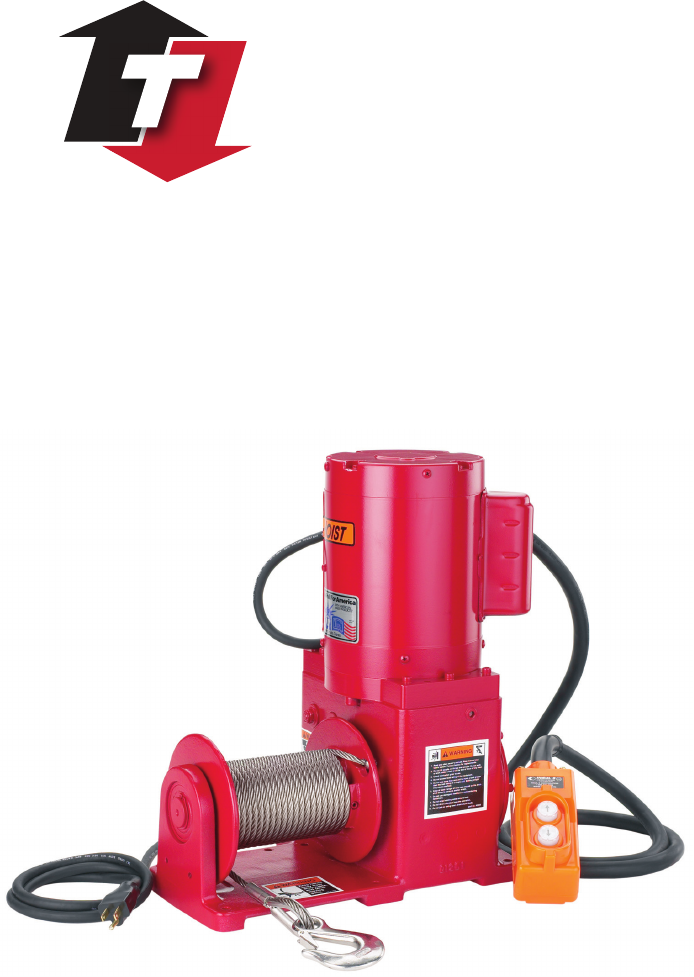
Read this Owner’s Manual
thoroughly before operating
the equipment. Keep it with
the equipment at all times.
Replacements are available
from Thern, Inc., PO Box 347,
Winona, MN 55987,
507-454-2996.
www.thern.com
IMPORTANT: Please record
product information on
page 2. This information is
required when calling the
factory for service.
A5445J-0917
Owner’s Manual
For
477 Series
Helical/Worm
Gear Power Winches
ORIGINAL TEXT
Thern
Winches & Cranes
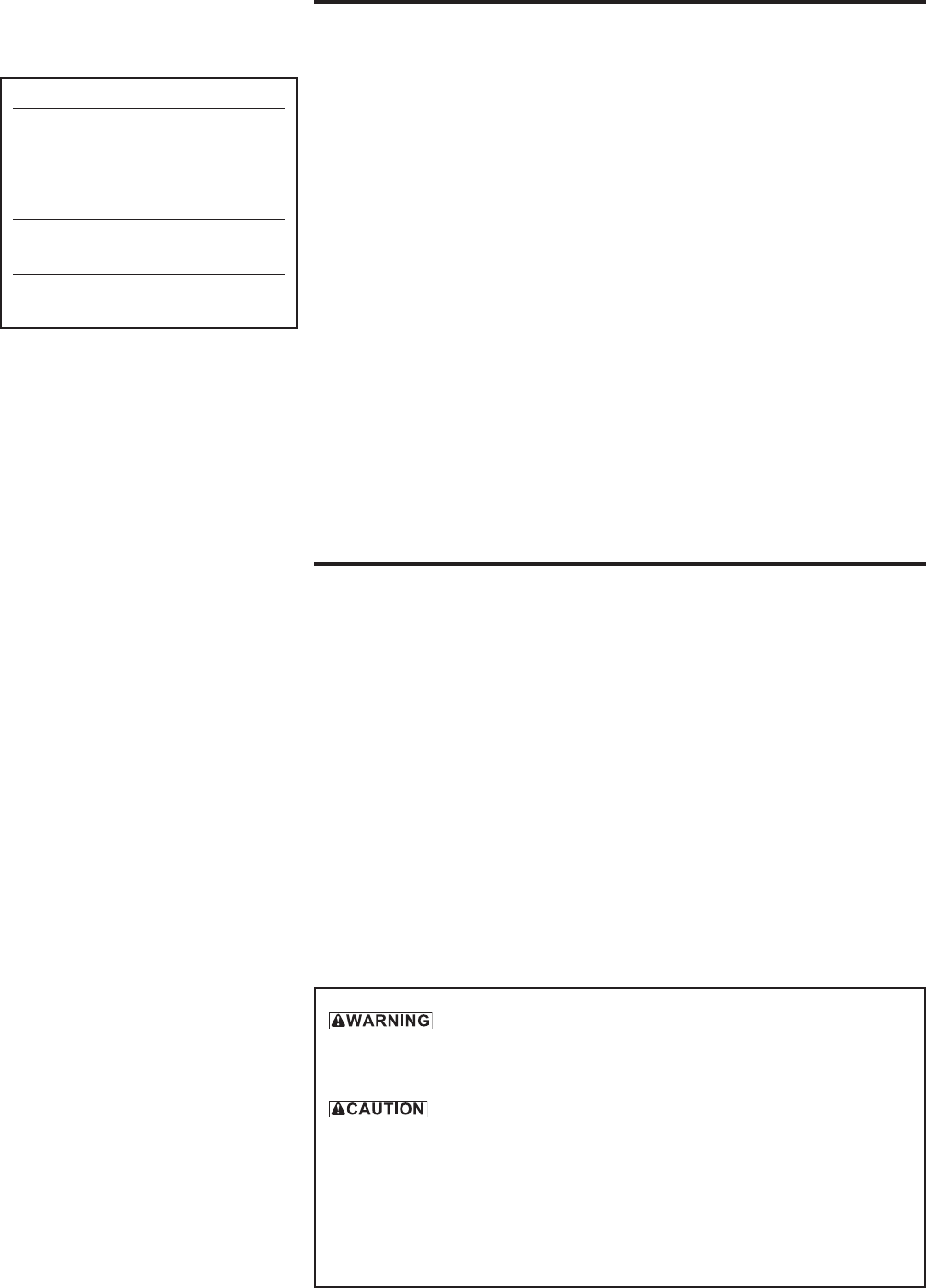
Owner's Manual for Thern 477 Series Power Winchespage 2
A5445J-0917
Two-Year Limited Warranty
Thern, Inc. warrants its products against defects in material or workmanship for two years from the date of purchase
by the original using buyer, or if this date cannot be established, the date the product was sold by Thern, Inc. to the
dealer. To make a claim under this warranty, contact the factory for an RGA number. The product must be returned,
prepaid, directly to Thern, Inc., 5712 Industrial Park Road, Winona, Minnesota 55987. The following information
must accompany the product: the RGA number, the date of purchase, the description of the claimed defect, and a
complete explanation of the circumstances involved. If the product is found to be defective, it will be repaired or
replaced free of charge, and Thern, Inc. will reimburse the shipping cost within the contiguous USA.
This warranty does not cover any damage due to accident, misuse, abuse, or negligence. Any alteration, repair or
modication of the product outside the Thern, Inc. factory shall void this warranty. This warranty does not cover any
costs for removal of our product, downtime, or any other incidental or consequential costs or damages resulting from
the claimed defects. This warranty does not cover brake discs, wire rope or other wear components, as their life is
subject to use conditions which vary between applications.
FACTORY AUTHORIZED REPAIR OR REPLACEMENT AS PROVIDED UNDER THIS WARRANTY IS THE
EXCLUSIVE REMEDY TO THE CONSUMER. THERN, INC. SHALL NOT BE LIABLE FOR ANY INCIDENTAL
OR CONSEQUENTIAL DAMAGES FOR BREACH OF ANY EXPRESS OR IMPLIED WARRANTY ON THIS
PRODUCT. EXCEPT TO THE EXTENT PROHIBITED BY APPLICABLE LAW, ANY IMPLIED WARRANTY
OF MERCHANTABILITY OR FITNESS FOR A PARTICULAR PURPOSE ON THIS PRODUCT IS LIMITED IN
DURATION TO THE DURATION OF THIS WARRANTY.
Some states do not allow the exclusion or limitation of incidental or consequential damages, or allow limitations on
how long an implied warranty lasts, so the above limitation or exclusion may not apply to you. This warranty gives
you specic legal rights, and you may also have other rights which vary from state to state.
Note: Thern, Inc. reserves the right to change the design or discontinue the production of any product without
prior notice.
About This Manual
The Occupational Safety and Health Act of 1970 states that it is the employer’s
responsibility to provide a workplace free of hazard. To this end, all equipment
should be installed, operated, and maintained in compliance with applicable
trade, industrial, federal, state, and local regulations. It is the equipment owner's
responsibility to obtain copies of these regulations and to determine the suitability
of the equipment to its intended use.
This Owner’s Manual, and warning labels attached to the equipment, are to serve
as guidelines for hazard-free installation, operation, and maintenance. They should
not be understood to prepare you for every possible situation.
Information contained in this Owner's Manual is applicable only to the Thern 477
Series Power Winches. Do not use this manual as a source of information for any
other equipment.
The following symbols are used for emphasis throughout this manual:
Please record the following:
Date Purchased:
Model No.:
Serial No.:
This information is required when
calling the factory for service.
Failure to follow ‘WARNING!’ instructions may result in equipment damage,
property damage, and/or serious personal injury.
Failure to follow ‘CAUTION!’ instructions may result in equipment damage,
property damage, and/or minor personal injury.
Important!
Failure to follow ‘important!’ instructions may result in poor performance of
the equipment.

Owner's Manual for Thern 477 Series Power Winches page 3
A5445J-0917
Suggestions for Safe Operation
DO the following:
Read and comply with the guidelines set forth in this Owner’s Manual. Keep
this manual, and all labels attached to the winch, readable and with the
equipment at all times. Contact Thern, Inc. for replacements.
Check lubrication before use.
Install the wire rope securely to the winch drum.
Keep at least 4 wraps of wire rope wound on the drum at all times, to serve as
anchor wraps. With less than 4 wraps on the drum the wire rope could come
loose, causing the load to escape.
Keep hands away from the drum, wire rope, and other moving parts of the equipment.
Keep all unnecessary personnel away from winch while in operation. Keep
out of the path of the load, and out of the path of a broken wire rope that
might snap back and cause injury.
Disconnect power before servicing the equipment.
DO NOT do the following:
Do not lift people, or things over people. Do not walk or work under a load or
in the line of force of any load.
Do not exceed the load rating of the winch or any other component in the
system. To do so could result in failure of the equipment.
Do not use more than one winch to move a load unless each winch was
designed for use in a multiple winch system.
Do not use damaged or malfunctioning equipment. To do so could result in
failure of the equipment.
Do not modify the equipment in any way. To do so could cause equipment failure.
Do not wrap the wire rope around the load. This damages the wire rope and
could cause the load to escape. Use approved rigging connectors to secure the
wire rope to the load.
Do not lift loads or pull loads on an incline unless the winch is equipped with
a load brake.
Do not divert your attention from the operation. Stay alert to the possibility of
accidents, and try to prevent them from happening.
Do not jerk or swing the load. Avoid shock loads by starting and stopping the
load smoothly. Shock loads overload the equipment and may cause damage.
Do not leave a suspended load unattended unless specic precautions have
been taken to secure the load and keep people away from the winch and out
from under the load.
Do not adjust the brake with the load suspended.
Do not exceed the 15 minute duty cycle rating of the winch. To do so could result in
equipment damage or failure.
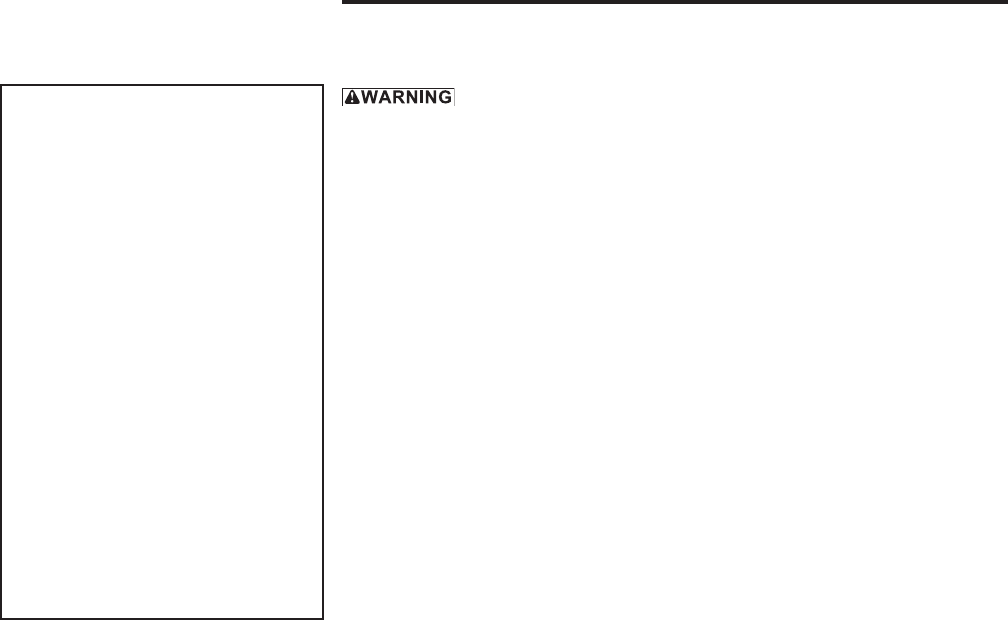
Owner's Manual for Thern 477 Series Power Winchespage 4
A5445J-0917
1.1 Installing the Winch
Do not install the winch in an area dened as hazardous by the National
Electric Code, unless installation in such an area has been thoroughly
approved.
Do not install the winch near corrosive chemicals, ammable materials,
explosives, or other elements that may damage the winch or injure the
operator. Adequately protect the winch and the operator from such elements.
Position the winch so the operator can stand clear of the load, and out of the
path of a broken wire rope that could snap back and cause injury.
Attach the winch to a rigid and level foundation that will support the winch
and its load under all load conditions, including shock loading.
1.1.1 CONSULT APPLICABLE CODES AND REGULATIONS for specic rules
on installing the equipment.
1.1.2 LOCATE THE WINCH in an area clear of trafc and obstacles. Make sure
the winch is accessible for maintenance and operation.
1.1.3 LOCATE THE WINCH in an area with adequate temperatures. The winch is
rated for operation in ambient temperatures ranging from 0° to 100° F.
1.1.4 MAINTAIN A FLEET ANGLE between 1/2 and 1-1/2 degrees. The proper
eet angle minimizes wire rope damage by helping the wire rope wind
uniformly onto the drum. See Figure 2.
1.1.5 POSITION THE WINCH to allow access for proper lubrication.
1.1.6 DETERMINE THE CORRECT MOUNTING POSITION of the winch.
Some models can only be oor mounted. See page 23 Motor Adapter
Assembly, footnote 2.
1.1.7 FASTEN THE WINCH securely to the foundation.
a FOR STANDARD PRODUCTS referred to in this manual, use 5/16 inch
coarse thread fasteners, grade 5 or better, torque dry to 17 ft. lb. without
lubrication. Make sure the winch is secured to a solid foundation able to
support the winch and the load under all conditions with design factors based
on accepted engineering practices.
b NON-STANDARD PRODUCTS that vary from the original design may
have different fastening requirements. Contact a structural engineer or Thern,
Inc. for this information.
TO COMPLY WITH LOCAL CODES, CONTACT A QUALIFIED
PROFESSIONAL TO OBTAIN PROPER STRUCTURE OR FOUNDATION
SPECIFICATIONS FOR THE MOUNTING OF THERN PRODUCTS.
Important!
• Inspect the winch immediately
following installation according
to the Instructions for Periodic
Inspection. This will give you
a record of the condition of the
winch with which to compare
future inspections.
• A qualied professional should
inspect or design the foundation
to insure that it will provide
adequate support.
• Locate the winch so it will be
visible during the entire operation.
• Do not weld the winch frame
to the foundation or support
structure. Welding the frame may
void warranty, contact Thern, Inc.
Use fasteners as instructed.
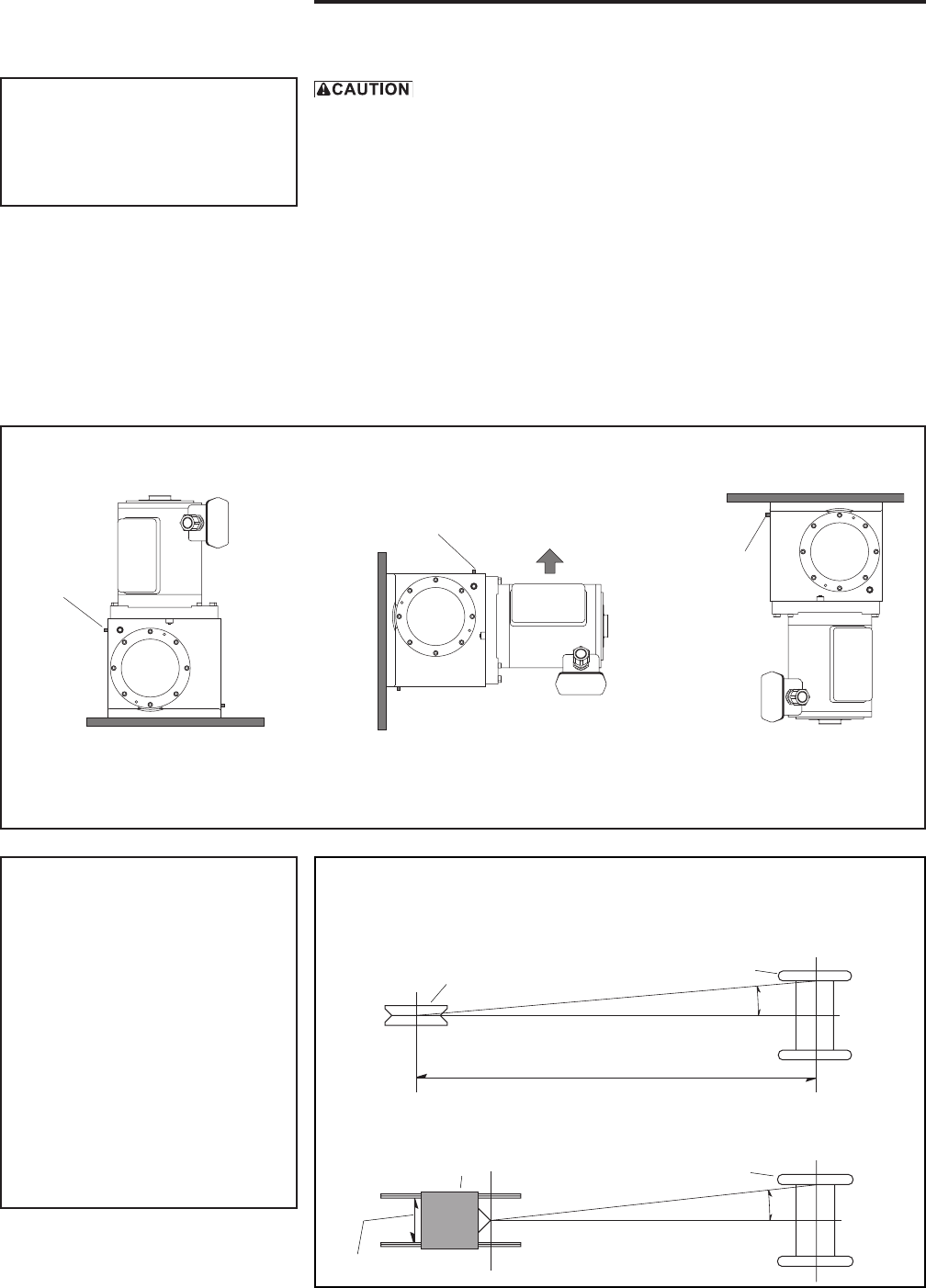
Owner's Manual for Thern 477 Series Power Winches page 5
A5445J-0917
1.2 Installing the Breather Plug
Install the breather plug to vent heat and pressure from the gearbox. Failure
to do so could result in pressure buildup which can cause the gearbox to leak
or damage the equipment.
For shipment, the gearbox is sealed with an oil plug, and the breather plug is
attached to the gearbox or shipped in a separate envelope.
1.2.1 REMOVE THE OIL PLUG and install the breather plug in the proper
location. Make sure the breather plug is above the level of the oil.
See Figure 1.
1.2.2 CHECK THE OIL LEVEL in the gearbox to make sure no oil was lost
during shipment. Refer to the Section 3.3 - Lubricating the Winch.
smooth drum
1/2 to 1-1/2 degrees
distance “A”
center
line
xed sheave or
roller guide
Important!
• Use a sheave or roller guide to
direct the wire rope to the drum
whenever possible.
• Install sheaves, tracks and other
equipment so they will remain
xed under all load conditions.
Follow the recommendations of
the equipment manufacturer.
• Use sheaves of proper diameter to
minimize wear on the wire rope.
Follow the recommendations of
the sheave manufacturer.
Figure 2 – Maintaining the Fleet Angle
When wire rope travels over a sheave or through a roller guide – maintain eet
angle by locating the sheave or guide an appropriate distance from the drum,
shown as distance “A”.
When wire rope travels directly to the load – maintain eet angle by controlling side-
to-side movement of the load with tracks or guide rails. Allowing the load to move
too far to one side causes stress on the drum ange which may cause damage.
1/2 to 1-1/2 degrees
center
line
smooth drum
tracks or guide rails
load
Important!
• Save the oil plug for use when
the winch is removed for storage
or transport.
Figure 1 – Breather Plug Installation
breather
plug
breather plug
position facing UP
to insure adequate
lubrication of gears
and bearings
breather
plug
oor mount wall mount ceiling mount
Some models can only be oor mounted. See page 23 Motor Adapter Assembly, footnote 2.
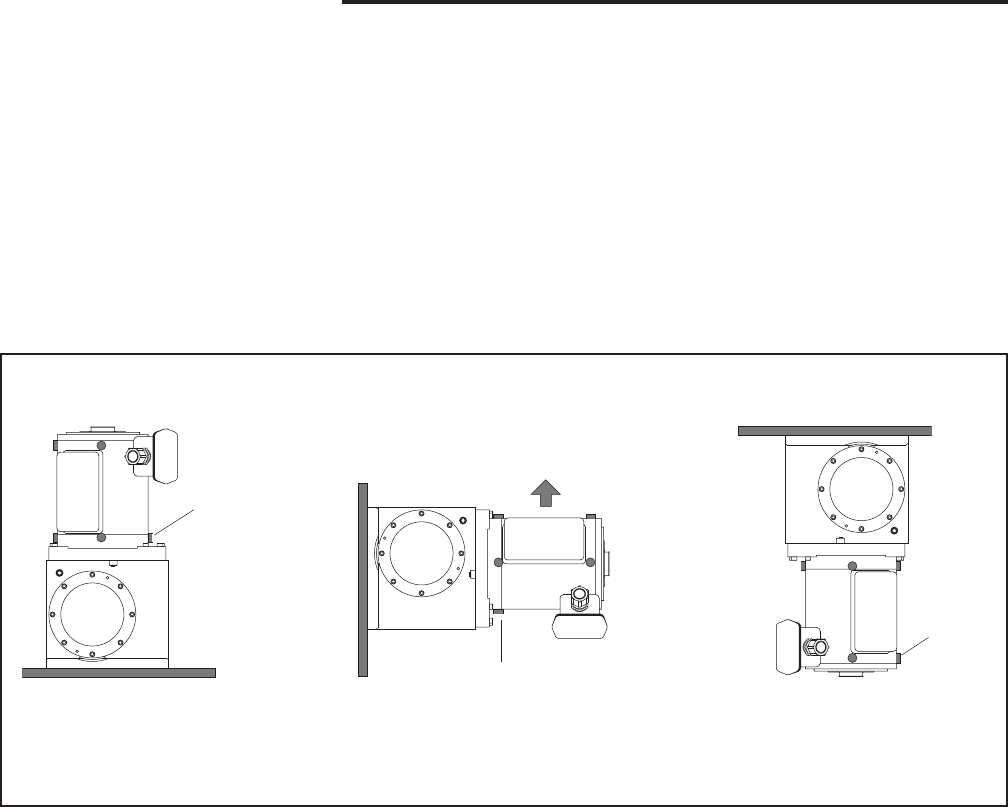
Owner's Manual for Thern 477 Series Power Winchespage 6
A5445J-0917
1.3 Removing Motor Drain Plugs
Some electric motors are equipped with screw plugs which are designed to be
removed to provide drain holes.
1.3.1 LOCATE THE LOWEST POINT ON THE ELECTRIC MOTOR.
1.3.2 REMOVE THE SCREW PLUG located at this lowest point. See Figure 3.
Figure 3 – Motor Drain Plug Removal
remove
screw plug
from this
location
remove screw plug
from this location
position facing UP
to insure adequate
lubrication of gears
and bearings
oor mount wall mount ceiling mount
remove
screw plug
from this
location
Some models can only be oor mounted. See page 23 Motor Adapter Assembly, footnote 2.

Owner's Manual for Thern 477 Series Power Winches page 7
A5445J-0917
1.4 Connecting Electric Power
Install proper branch circuits, disconnect devices, protection, and grounding
as required by article 430 of the National Electric Code.
All electrical work must be performed by a licensed electrician. Failure to do
so could result in electric shock or poor winch operation.
All control devices must be momentary contact type. Install all control devices
so the winch motor will stop when the operator releases the device.
Locate control devices so the operator will be able to view the load through
the entire operation.
Locate control devices so the operator will be clear of the load, the wire rope,
and the path of a broken wire rope that could snap back and cause injury.
It is the responsibility of the owner to provide equipment for controlling the winch.
Controls are available from Thern. The following guidelines are supplied as a
reference for the installer.
1.4.1 CONSULT APPLICABLE CODES AND REGULATIONS for specic
instructions regarding power supply installation and hookup.
1.4.2 FOR ELECTRIC WINCHES: install a fuse or circuit breaker, and a
disconnect device in the power supply circuit, as required by the National
Electric Code. The disconnect device should be a switch you can lock in the
off position to prevent unauthorized use of the winch.
1.4.3 CONNECT THE POWER CORD to a grounded outlet.
1.4.4 FOR PNEUMATIC WINCHES: install a regulator, lter, lubricator and drier
in the air supply line. Failure to operate motor with clean, dry, lubricated
air will void warranty.
1.4.5 FOR HYDRAULIC WINCHES: install a lter in the hydraulic supply line.
Use Mobil DTE hydraulic uid, or equal, with a viscosity range of 100 –
200 SUS.
1.4.6 INSTALL A CONTROL DEVICE in the power supply line and connect
power to the motor. Make sure the control device is a momentary contact
type so the motor will stop when the operator releases the control.
1.4.7 CONNECT OTHER EQUIPMENT to the power supply as necessary.
1.4.8 CHECK POWER SUPPLY at the motor and make sure it agrees with the
motor rating. Do not operate the winch until proper power is supplied to the
motor.
1.4.9 TEST CONNECTIONS by operating the winch. The rotation of the drum
must agree with the labels on the control device, and the motor must stop
when the control is released.
CONTACT THE FACTORY OR A QUALIFIED PROFESSIONAL FOR HELP.
Important!
• Use components rated for the
power supply you will be using.
• Always disconnect power when
the winch is not in use.
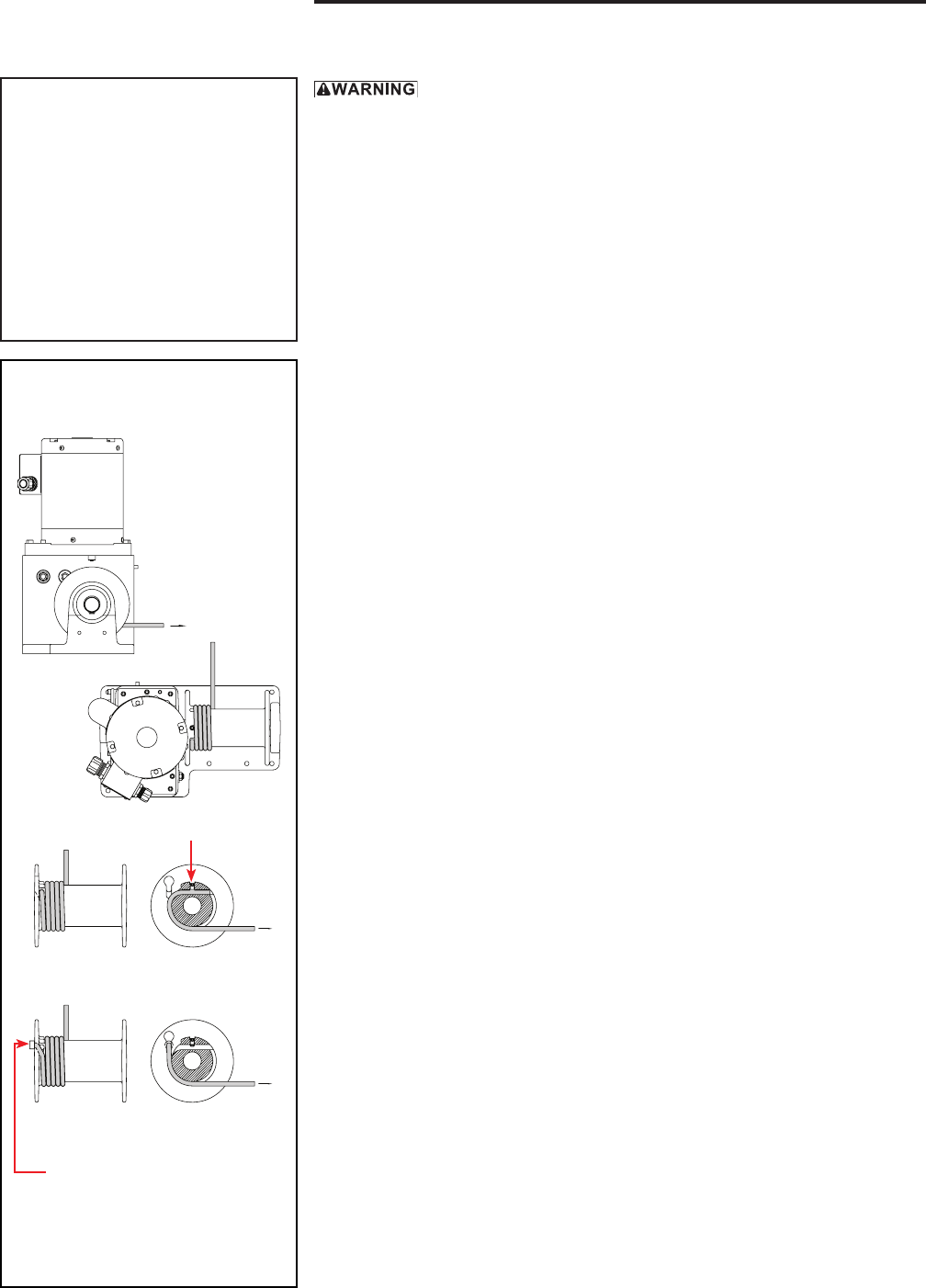
Owner's Manual for Thern 477 Series Power Winchespage 8
A5445J-0917
1.5 Installing the Wire Rope
Install the wire rope securely to the winch drum. A poorly secured wire rope
could come loose from its anchor and allow the load to escape.
Install the wire rope so it is wound correctly as shown or the winch and brake
will not work properly, and could allow the load to escape, see Figure 4.
Anchor tting must clear the reducer frame when operating. Binding of the
anchor tting between the frame and ange could damage the equipment.
1.5.1 PURCHASE THE PROPER WIRE ROPE for your application. Keep the
following in mind when selecting a wire rope. Contact a reputable wire rope
supplier for help.
a BREAKING STRENGTH of new wire rope should be at least 3 times
greater than the largest load placed on the winch. If loads are lifted or pulled
on an incline, the breaking strength must be at least 5 times greater than the
largest load. These are minimum values and will vary with the type of load
and how you are moving it.
b WIRE ROPE LAY must agree with the winding direction of the drum to help
insure proper winding.
c WE RECOMMEND 7x19 galvanized aircraft cable for diameters up to 5/16 inch.
1.5.2 ANCHOR THE WIRE ROPE to the drum using either the set screw or quick
disconnect anchor.
a SET SCREW ANCHOR. See Figure 4.
• PASS THE WIRE ROPE under the drum from the front and position it in
the slot in the drum. Make sure at least 1/2 inch of wire rope extends past
the set screw, and the end of the wire rope does not protrude out where it
will interfere with wire rope winding onto the drum.
• TIGHTEN THE SET SCREW to hold the wire rope in place. Hold the
wire rope down while tightening so the wire rope does not push up out of
the slot.
b QUICK DISCONNECT ANCHOR. See Figure 4.
• PASS THE WIRE ROPE under the drum from the front and position the
anchor tting in the groove in the drum.
• PULL THE WIRE ROPE to rmly lodge the anchor tting in place.
1.5.3 WIND FOUR FULL WRAPS of wire rope onto the drum by operating the
winch while holding the wire rope taught. These wraps serve as anchor
wraps and must remain on the drum at all times. See Figure 4.
CONTACT A REPUTABLE WIRE ROPE SUPPLIER FOR HELP.
Important!
• Use wire rope and other rigging
equipment rated for the size of the
largest load you will be moving.
• Do not drag the wire rope
through dirt or debris that could
cause damage, or poor operation.
• Always wear protective clothing
when handling wire rope.
Figure 4 – Installing the
Wire Rope
Wire rope assemblies with anchor ttings
can be purchased from Thern, Inc.
anchor tting installation
anchor tting must clear
frame and drum ange
when operating.
install the
wire rope
so it is
underwound
on the drum
as shown
set screw
recessed anchor installation

Owner's Manual for Thern 477 Series Power Winches page 9
A5445J-0917
2.1 General Theory of Operation
2.1.1 THE FORCE REQUIRED to move the load must not exceed the load rating of
the winch. Consider the total force required to move the load, not the weight of the
load.
2.1.2 THE AMOUNT OF TIME required to move the load must not exceed the
15 minute duty cycle rating of the winch. Allow the winch to cool between
cycles.
2.1.3 EQUIPMENT CAN DEVELOP forces that will exceed the load rating. It is
the responsibility of the equipment user to limit the size of the load. Inspect
the equipment regularly for damage according to the instructions contained
in this manual and in component manufacturer’s information.
2.1.4 USE A LOAD BRAKE on all winches used to lift loads or pull loads on an
incline. Although a new winch may appear to hold the load in place, this
characteristic will diminish with use. Do not depend on gearing to hold the
load in place.
2.1.5 PERFORMANCE RATINGS of the equipment are affected by the amount of
wire rope wound on the drum, the way in which it is wound, and the way the
winch is used.
a DRUM CAPACITY depends on how tightly and evenly the wire rope is
wound on the drum. Actual drum capacities are usually 25-30% less than
values shown in performance tables, due to loose winding and overlapping.
b LINE SPEED increases with each additional layer of wire rope wound onto
the drum. Line speed will also vary with load weight and power supply for
pneumatic and hydraulic models. Load weight does not affect line speed for
electric models.
c LOAD RATING represents the maximum force that can be placed on new
equipment. Load ratings are assigned values for specic amounts of load
travel or wire rope accumulation. The load rating decreases as layers of wire
rope accumulate on the drum.
2.1.6 DUTY RATINGS refer to the type of use the equipment is subject to.
Consider the following when determining duty rating. This winch has a 15
minute duty cycle rating.
a ENVIRONMENT: harsh environments include hot, cold, dirty, wet,
corrosive, or explosive surroundings. Protect the equipment from harsh
environments when possible.
b MAINTENANCE: poor maintenance, meaning poor cleaning, lubrication,
or inspection, leads to poor operation and possible damage of the equipment.
Minimize poor maintenance by carefully following the instructions
contained in this manual.
c LOADING: severe loading includes shock loading and moving loads that
exceed the load rating of the equipment. Avoid shock loads, and do not
exceed the load rating of the equipment.
d FREQUENCY OF OPERATION: frequent or lengthy operations increase
wear and shorten the life span of gears, bearings, and other components.
Increase maintenance of the equipment if used in frequent operations.
Length of operation should not exceed the 15 minute duty cycle rating.
CONTACT THE FACTORY FOR MORE INFORMATION.
Important!
• Limit nonuniform winding by
keeping tension on the wire rope
and by maintaining the proper
eet angle.
• To help insure rated performance,
make sure voltage at the motor is
equal to the motor’s voltage rating.
• It is your responsibility to detect
and account for different factors
affecting the condition and
performance of the equipment.
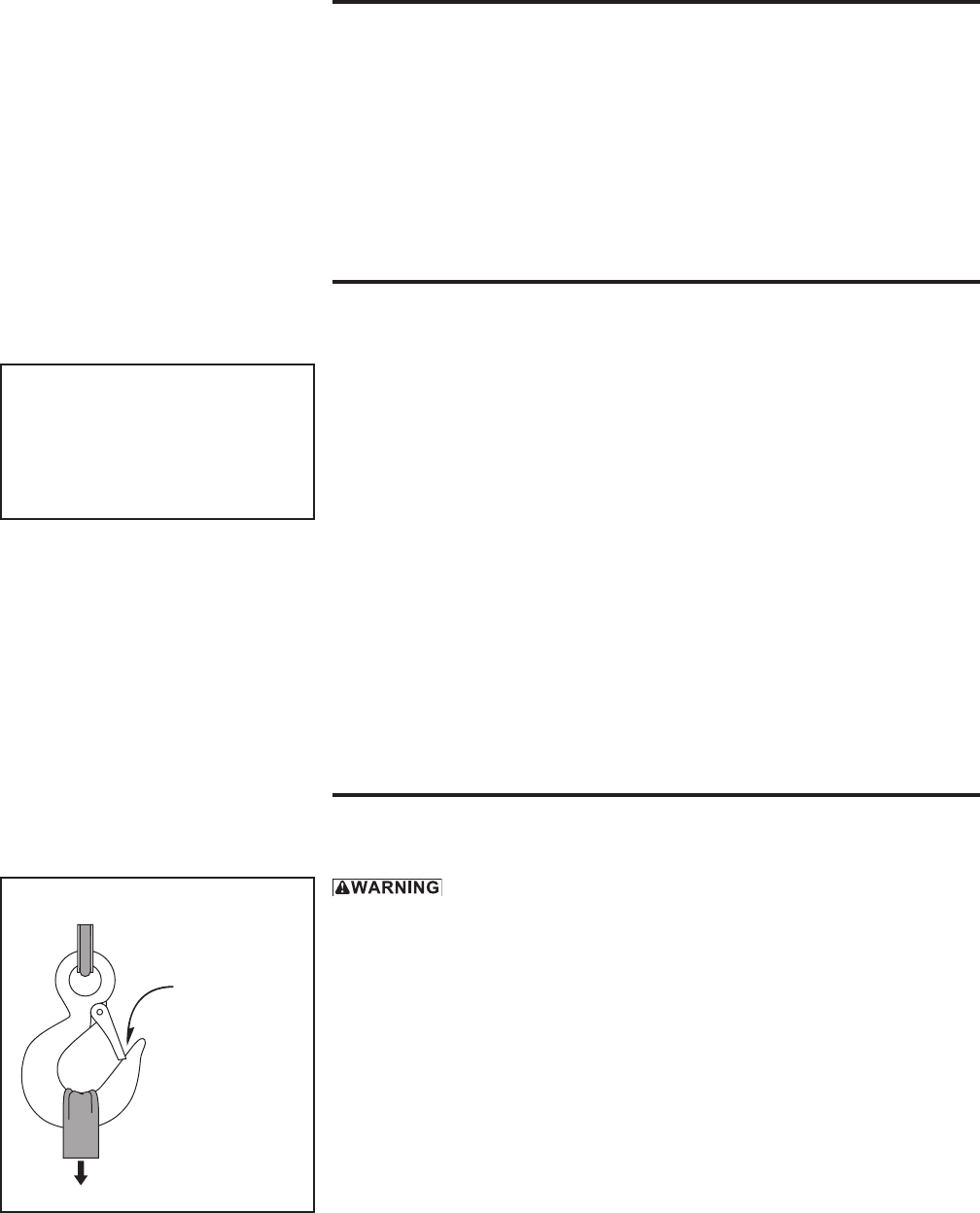
Owner's Manual for Thern 477 Series Power Winchespage 10
A5445J-0917
2.2 Breaking-In the Winch
2.2.1 BREAK-IN OCCURS during the rst 30 to 60 minutes of operation. During
break-in, mating surfaces become polished, and clearances increase. This is
desired for efcient operation of bearings and gears.
2.2.2 INSPECT THE WINCH following break-in according to the Instructions for
Periodic Inspection. See section 3.4 - Inspecting the Equipment.
2.3 Preparing for Operation
2.3.1 CONSIDER THE OPERATION. Do not begin until you are sure you can
perform the entire operation without hazard.
2.3.2 INSPECT ALL COMPONENTS of the system.
a INSPECT THE WINCH and other equipment according to the Instructions
for Frequent Inspection.
b OPERATORS MUST be in good health, alert, thoroughly trained in
operating the equipment, and properly clothed (hard hat, safety shoes and
safety glasses, no loose clothing).
c LOAD MUST be clear of other objects and free to move. Make sure the load
will not tip, spin, roll away, or in any way move uncontrollably.
2.3.3 KNOW YOUR LOAD and make sure you do not exceed the load rating of
the winch or any other equipment in the system.
2.4 Attaching the Load
Do not wrap the wire rope around the load. This damages the wire rope and
could cause the load to escape. Use a sling or other approved rigging device.
2.4.1 CLEAR OBJECTS from the path of the load so you can move it freely and
observe it at all times during the operation.
2.4.2 ATTACH THE LOAD using a nylon sling, or other approved rigging device.
Follow the recommendations of the sling manufacturer.
a SEAT THE SLING in the saddle of the hook with the hook latch completely
closed. See Figure 5.
b CENTER THE LOAD on the hook so it will remain balanced and not tip or
rotate to one side.
Important!
• When determining whether the
load will exceed the load rating,
consider the total force required
to move the load.
Figure 5 – Attaching Load
latch closed
tight against
hook
sling seated in
saddle of hook

Owner's Manual for Thern 477 Series Power Winches page 11
A5445J-0917
2.5 Moving the Load
2.5.1 MOVE THE LOAD slowly and smoothly, only a small distance at rst.
Make sure the load is balanced and securely attached before continuing.
2.5.2 USE THE CONTROL DEVICE to operate the winch. The control device
should be momentary contact type, so the winch will stop when the operator
releases the control.
2.5.3 DO NOT EXCEED duty cycle rating of the winch. The equipment is rated
for a 15 minute duty cycle.
2.5.4 OBSERVE THE WIRE ROPE as it winds onto the drum. If it becomes
loose, uneven, or overlapped, stop the operation and rewind the wire rope
before continuing. Continued operation with overlapped or uneven wire
rope can damage the wire rope and shorten its life.
2.5.5 ALLOW THE WINCH TO COOL DOWN to ambient temperature in rest
periods between operations.
2.5.6 OBSERVE THE GEARBOX AND BRAKE during operation for signs of
overheating. Frequent overheating may be a sign of damage, or may
indicate the need for a larger power winch.
a WATCH FOR SMOKE, the smell of burnt oil, and other signs of
overheating. Use a thermocouple or other device to monitor gearbox
temperature. The temperature of the oil should not exceed 180° F.
b STOP THE OPERATION if the gearbox or brake overheats, and allow the
winch to cool until it reaches ambient temperature. Continued operation
may cause damage.
Important!
• Obey a stop signal from anyone.
• Maintain tension on the wire
rope to keep it tightly and evenly
wound on the drum.
• If the winch and load are not
visible during the entire operation,
get help from another person.
• Appoint a supervisor if more
than one person is involved in
the operation. This will reduce
confusion and increase safety.
• When lifting a load, use a tag line
to keep the load from swinging or
twisting, while keeping yourself
away from the load.

Owner's Manual for Thern 477 Series Power Winchespage 12
A5445J-0917
2.6 Emergency Operation
(for models equipped with this feature)
Do not adjust the brake with the load suspended. Accidental release of the
brake could allow the load to escape.
Do not leave a suspended load unattended unless specic precautions have
been taken to secure the load and keep unnecessary personnel away from the
winch and from under the load.
2.6.1 IN CASE OF POWER FAILURE, turn the control device to OFF and
DISCONNECT electric power. Leave electric power DISCONNECTED.
2.6.2 MAKE SURE SAFETY PRECAUTIONS have been taken to secure the load
and keep unnecessary personnel away from the winch and from under the
load while operating the emergency hand crank. Assign a person to observe
and control the load.
2.6.3 IF EQUIPPED WITH A BRAKE MOTOR you must disengage the brake on
the motor before using the emergency hand crank. Operating the emergency
hand crank with the brake on the motor engaged could result in equipment
damage or failure.
a IT IS RECOMMENDED to have more than one person operate the winch
using the emergency hand crank.
b ASSIGN ONE PERSON to operate the hand crank while another is assigned
to operate the brake. Have control of the hand crank before disengaging the
brake on the motor. Accidental release of the brake could allow the load to
escape.
c ALWAYS FOLLOW the brake manufacturers operating instructions for
engaging or disengaging the brake.
2.6.4 DO NOT USE AN IMPACT WRENCH to operate the emergency hand
crank option of the winch. To do so could result in equipment damage or
failure. Use a drill-motor.
2.6.5 DO NOT EXCEED THE 15 MINUTE DUTY CYCLE rating of the winch if
operating with a drill-motor and do not operate the winch with a drill-motor
that exceeds 400 rpm. To do so could result in equipment damage or failure.
2.6.6 IF EQUIPPED WITH A BRAKE MOTOR you must engage the brake on
the motor and remove the handle or drill-motor before operating the winch
under power.
ANY QUESTIONS ON OPERATING THE EMERGENCY HAND CRANK
OPTION OR WINCH APPLICATION CONTACT THERN, INC.
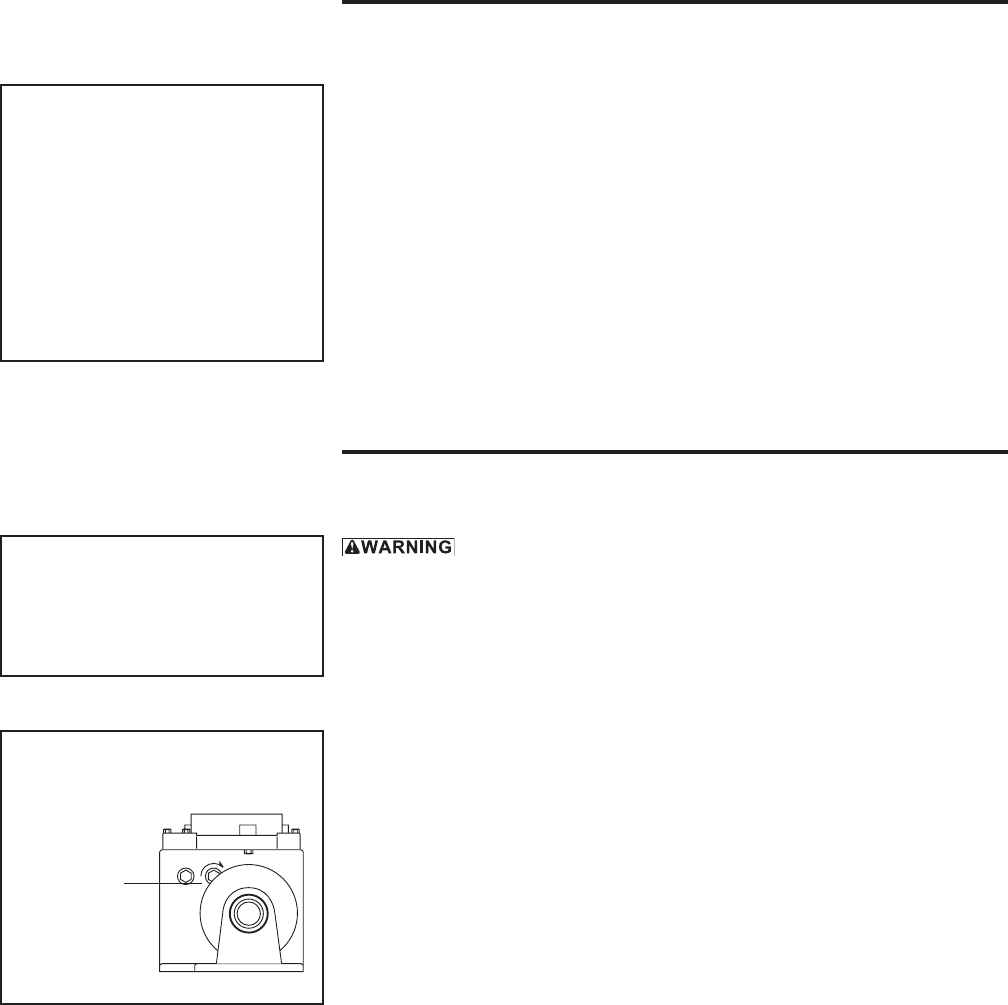
Owner's Manual for Thern 477 Series Power Winches page 13
A5445J-0917
3.1 Cleaning the Winch
Clean the winch to remove dirt and help prevent rust and corrosion.
3.1.1 CLEAN THE WINCH every 6 months or whenever it is dirty.
a WIPE ALL EQUIPMENT to remove dirt and grease.
b LEAVE A LIGHT FILM of oil on all surfaces to protect them against rust
and corrosion.
c WIPE OFF excessive amounts of oil to avoid the accumulation of dirt.
3.1.2 REMOVE ALL UNNECESSARY OBJECTS from the area surrounding the
winch.
3.2 Adjusting the Brake
Do not adjust the brake with the load suspended. Accidental release of the
brake could allow the load to escape.
3.2.1 ADJUST THE BRAKE whenever it appears to need adjustment, or at least
every 3 months.
3.2.2 CHECK THE BRAKE by operating the winch with a test load equal to the
winch load rating.
a RAISE THE LOAD, then lower it and stop it about one foot off the ground.
b OBSERVE THE LOAD when stopped. If it continues to coast or creep, the
brake should be tightened.
3.2.3 TIGHTEN THE BRAKE by turning the adjusting nuts clockwise about 1/4
turn. Continue to test and tighten the brake by alternate tightening of each
brake nut until it stops and holds the load securely. See Figure 6.
a A DECELERATION DISTANCE while stopping is typically 6 inches.
b IF THE LOAD continues to coast or creep contact the factory.
Important!
Increase the frequency of
maintenance procedures if the winch
is:
• Operated for long periods.
• Used to pull heavy loads.
• Operated in wet, dirty, hot, or
cold surroundings.
Important!
• Do not overtighten the brake,
since this will cause parts to wear
and become damaged.
Figure 6 – Adjusting the
Brake
turn brake
adjusting nuts
clockwise
1/4 turn
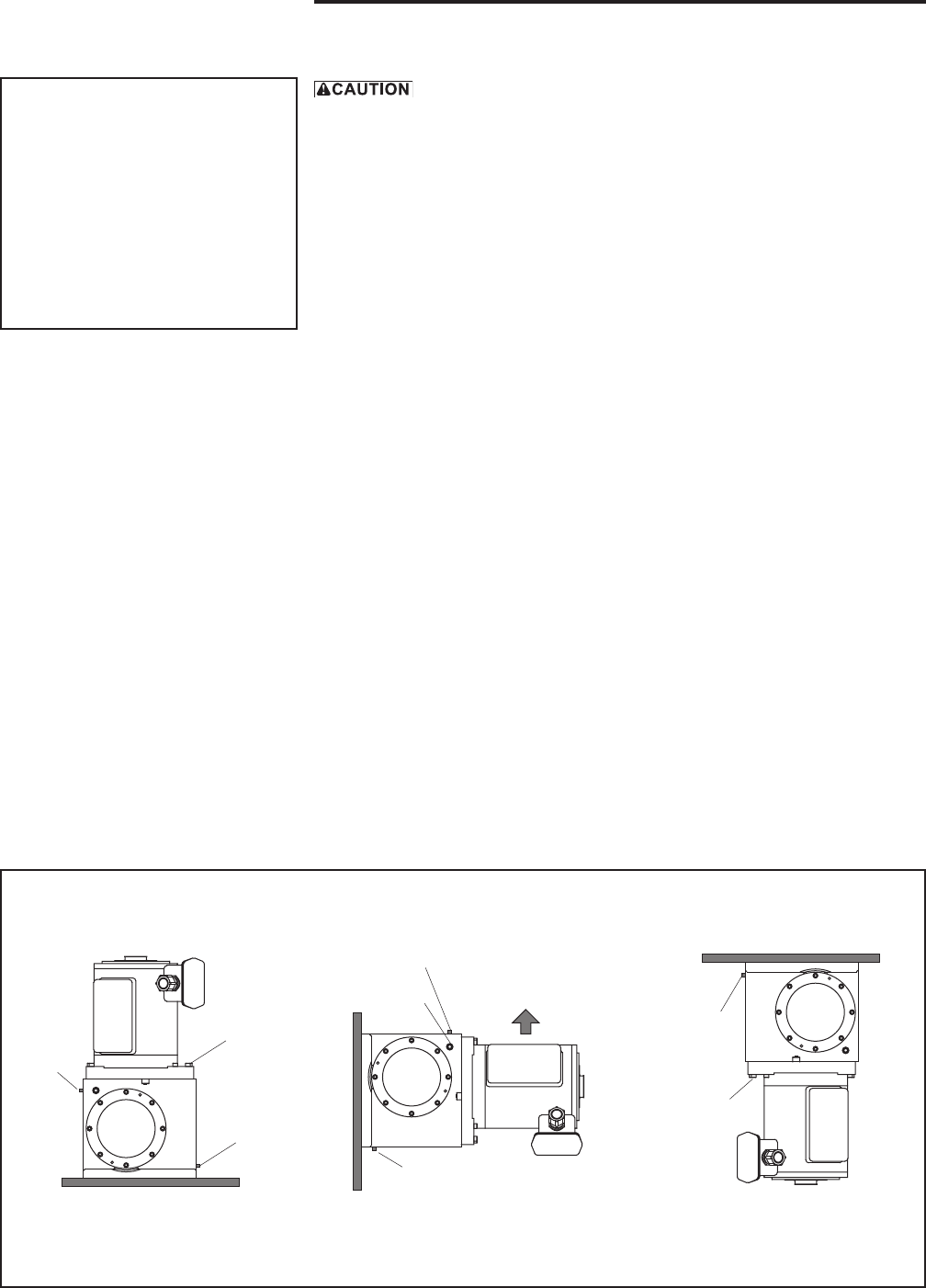
Owner's Manual for Thern 477 Series Power Winchespage 14
A5445J-0917
Important!
• Do not leave plug holes in the
reducer open. Open plug holes
will allow dirt and moisture to
contaminate the lubrication.
• Make sure lubricant has a
temperature rating appropriate for
the ambient temperatures of the
operation.
3.3 Lubricating the Winch
Make sure the breather plug is clean and open to vent heat and pressure. Poor
ventilation may cause overheating and result in equipment damage.
Check the gearbox for proper level before operating. Too much or too little oil
will cause overheating and result in equipment damage.
Lubricate the winch properly to help protect it from wear and rust. Read the
following instructions carefully.
3.3.1 FOR 477 SERIES, the winch is shipped from the factory with proper amount
(92 ounces) of Mobilgear 600 XP220 lubricant in the gearbox. Lubricate the
winch as follows. See Figure 7.
3.3.2 MOTOR BEARINGS are typically lubricated for life by the manufacturer.
a REPLACE MOTOR BEARINGS if the motor is disassembled for any reason.
b REFER TO MOTOR MANUFACTURER’S information for specic
instructions regarding motor lubrication.
3.3.3 CHECK OIL LEVEL before every operation and every 10 hours during
operation. Remove the level check plug and make sure oil is even with
the plug hole. Add oil to the gearbox if necessary. Do not use synthetic
lubricants and do not mix different lubricants. See Figure 7.
3.3.4 CHANGE GEARBOX OIL at least every 6 months, or whenever it is dirty
or contaminated. Remove the drain plug to drain oil from the gearbox. See
Figure 7.
3.3.5 LUBRICATE THE WIRE ROPE and other equipment by following the
manufacturer's recommendations.
Figure 7 – Lubricating the Winch
ller plug
drain plug
position facing UP
to insure adequate
lubrication of gears
and bearings
ller/level
check plug
oor mount wall mount ceiling mount
level
check
plug
level check plug
drain plug
ller plug
drain plug
Some models can only be oor mounted. See page 23 Motor Adapter Assembly, footnote 2.

Owner's Manual for Thern 477 Series Power Winches page 15
A5445J-0917
3.4 Inspecting the Equipment
Do not use damaged or malfunctioning equipment. Place an “OUT OF ORDER”
sign on the winch. Do not use the winch until the sign is removed by a qualied
maintenance person who has completely corrected the problem.
Inspect the winch to detect signs of damage or poor operation before they
become hazardous.
3.4.1 CONSULT APPLICABLE CODES AND REGULATIONS for specic rules
on inspecting the winch and other equipment.
3.4.2 CONSULT MANUFACTURER’S RECOMMENDATIONS for information
on inspecting the wire rope and other equipment.
3.4.3 Instructions for Frequent Inspection
a VISUALLY INSPECT the entire winch and all other equipment involved in
the operation.
• Check all equipment for cracks, dents, bending, rust, wear, corrosion and
other damage.
• Make sure the wire rope is installed correctly and anchored securely to
the drum.
• Make sure the winch is properly lubricated.
• Check the gearbox for signs of leakage, and make sure it is lled with the
proper lubricant. Contact the factory if there are any signs of lubricant
leaking from the gearbox,
• Make sure the breather plug is clean, open, and installed correctly.
• Make sure mounting fasteners are tightened securely.
• Make sure the foundation is in good condition, and capable of supporting
the winch and its load under all load conditions.
• Check electrical wiring and connections for wear, corrosion, cuts, and
other damage.
b TEST WINCH PERFORMANCE by moving a test load not exceeding the
load rating.
• Listen for unusual noises, and look for signs of damage as you operate the winch.
• Make sure the wire rope winds evenly and tightly onto the drum. If it is
loose or uneven, rewind it before continuing.
• Make sure the load moves smoothly, without hesitation or strain.
• Make sure the winch responds to the control device. It must rotate as shown
on the control labels, and it must turn off when you release the control.
• Check the brake. Raise the load, then lower it and stop it a few feet off the
ground. If the load continues to coast or creep, the brake needs adjustment.
See Section 3.2 - Adjusting the Brake.
Completely correct all problems before continuing. Use the Troubleshooting
Chart to help determine the cause of certain problems. See Table 2.
Important!
• Start an inspection program as
soon as you put the winch into use.
• Appoint a qualied person to
be responsible for regularly
inspecting the equipment.
• Keep written records of
inspection. This allows
comparison with comments from
previous inspections so you
can see changes in condition or
performance.
Perform frequent inspections:
• Before each operation.
• Every 3 hours during operation.
• Whenever you notice signs of
damage or poor operation.
Frequent Wire Rope Inspection:
• Use ASME B30.7 as a guideline
for rope inspection, replacement
and maintenance.
• Check the wire rope, end connec-
tions and end ttings for corrosion,
kinking, bending, crushing, bird-
caging or other signs of damage.
• Check the number, distribution
and type of visible broken wires.
See paragraph 3.4.4 c and Figure 8.
• Check the wire rope for reduc-
tion of rope diameter from loss of
core support, or wear of outside
wires. See Figure 10.
• Take extra care when inspecting
sections of rapid deterioration
such as sections in contact with
saddles, sheaves, repetitive pickup
points, crossover points and end
connections.

Owner's Manual for Thern 477 Series Power Winchespage 16
A5445J-0917
3.4.4 Instructions for Periodic Inspection, see Table 1.
a VISUALLY INSPECT the winch and all other equipment.
• Disassembly may be required in order to properly inspect individual
components. Contact factory for assembly/disassembly instructions.
Disassembly of the gearbox before contacting Thern, Inc voids all
warranties.
• Check the nish for wear, aking, or other damage.
• Check all equipment for cracks, dents, bending, rust, wear, corrosion and
other damage. If the equipment was overloaded, or if you notice cracks or
other signs of overloading and damage, promptly remove equipment from
use and have it repaired or replaced. DO NOT CONTINUE TO USE
DAMAGED OR OVERLOADED EQUIPMENT OR WIRE ROPE.
• Check all fasteners for stripped threads, wear, bending, and other damage.
• Check the gearbox for signs of leakage. Contact the factory if there are
any signs of lubricant leaking from the gearbox,
• Make sure the breather plug is clean, open and installed correctly.
• Make sure all labels and plates are readable, rmly attached, free of
damage and clean. Replacements are available from the factory.
b DRAIN A SMALL AMOUNT OF OIL from the gearbox into a clean
container.
• Check the oil for dirt, metal particles, water, and other signs of
contamination. Completely drain the gearbox if oil is contaminated.
• Make sure the gearbox is properly lubricated. See Section 3.3 -
Lubricating the Winch.
c INSPECT THE WIRE ROPE according to the wire rope manufacture's
recommendations or follow accepted industry standards for wire rope
inspections.
• Always wear protective clothing when handling wire rope.
• Check the entire length of wire rope for bent wires, crushed areas, broken
or cut wires, corrosion, and other damage. Carefully inspect areas that
pass over sheaves or through roller guides.
• Note the location and concentration of broken wires. Replace wire rope if
more than 6 wires are broken in one lay, or more than 3 wires are broken
in one strand in one lay. See Figure 8.
• Make sure hooks and other ttings are securely attached to the wire rope,
and the wire rope where they are attached is not frayed, corroded, broken,
or otherwise damaged.
• Measure the throat opening, thickness, and twist of the hook. Replace the
hook if it shows signs of damage. See Figure 9.
• Make sure hook latch opens without binding and closes when released.
• Check the anchor holes in the drum and the surrounding area for signs of
wear or distortion.
twist
throat
opening
thickness
Figure 9 – Load Hook
Inspection
The wire rope assembly must be
replaced if the throat opening is
15% wider than nominal, if the
thickness is 10% less than nomi-
nal, or if the hook is twisted 10° or
more.
Perform periodic inspections:
• Every 6 months.
• Whenever you return the winch
to service from storage.
• Whenever you notice damage
or poor operation in a frequent
inspection.
• Whenever you have, or think you
may have, overloaded or shock
loaded the winch.
wire
strand
one
lay
Figure 8 – Broken Wires
Wire rope assembly must be re-
placed if more than 6 wires are
broken in one lay, or if more than
3 wires are broken in one strand
in one lay.
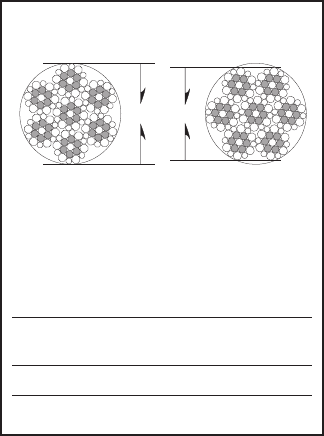
Owner's Manual for Thern 477 Series Power Winches page 17
A5445J-0917
correct
incorrect
Figure 10 – Rope Diameter
diameter
The wire rope assembly must be
replaced if the diameter measures
less than the minimum diameter
at any point.
wire rope
diameter minimum diameter
1/4 in 15/64 in (.2344 in)
5/16 in 19/64 in (.2969 in)
d MOVE THE DRUM with your hands. Check for excessive movement
indicating worn or loose gears, bearings, or shafts. Slight endplay in the
driveshaft is normal. Excessive movement is caused by overloading or
overheating, and is a sign that your application may require a larger winch.
e PLACE enough weight to keep the wire rope straight and tightly drawn.
• Measure the diameter of the wire rope, especially in areas where wear
is noticeable. Replace the wire rope if the diameter measures below the
minimum diameter at any point. See Figure 10.
f INSPECT THE FOUNDATION AND RIGGING
• Check mounting fasteners for stripped threads, wear, and other damage.
• Check the foundation for cracks, corrosion, and other damage.
g TEST WINCH PERFORMANCE by operating the winch with a load equal
to the load rating.
• Listen for unusual noises, and look for signs of damage as you operate the
winch.
• Make sure the wire rope winds evenly and tightly onto the drum. If it is
loose or uneven, rewind it before continuing.
• Observe the rotating drum, look for signs of loose or misaligned bearings.
• Make sure the load moves smoothly, without hesitation or strain.
• Make sure the winch responds to the control device. It must rotate as
shown on the control labels, and it must turn off when you release the
control.
• Check the brake. Raise the load, then lower it and stop it a few feet
off the ground. If the load continues to coast or creep, the brake needs
adjustment. See Section 3.2 - Adjusting the Brake.
h DISCONNECT POWER and inspect power supply equipment.
• Check supply lines for wear, cuts, corroded connections, and other damage.
• Check control devices and other power supply components for signs of
moisture, corrosion, burn marks, cracks, and other damage.
i CONNECT POWER.
• Check power supply at the motor and make sure it agrees with the motor
rating. Do not operate the winch until proper power is supplied to the motor.
Completely correct all problems before continuing. Use the troubleshooting
chart to help determine the cause of certain problems. See Table 2.

Owner's Manual for Thern 477 Series Power Winchespage 18
A5445J-0917
Table 1 – Inspection Checklist
damages problems
general
fasteners
reducer
wire rope
end connections
hook or other device
drum
motor
brake
power supply
clutch
labels and plates
comments
authorized signature date
checked boxes indicate damage or problem in need of repair
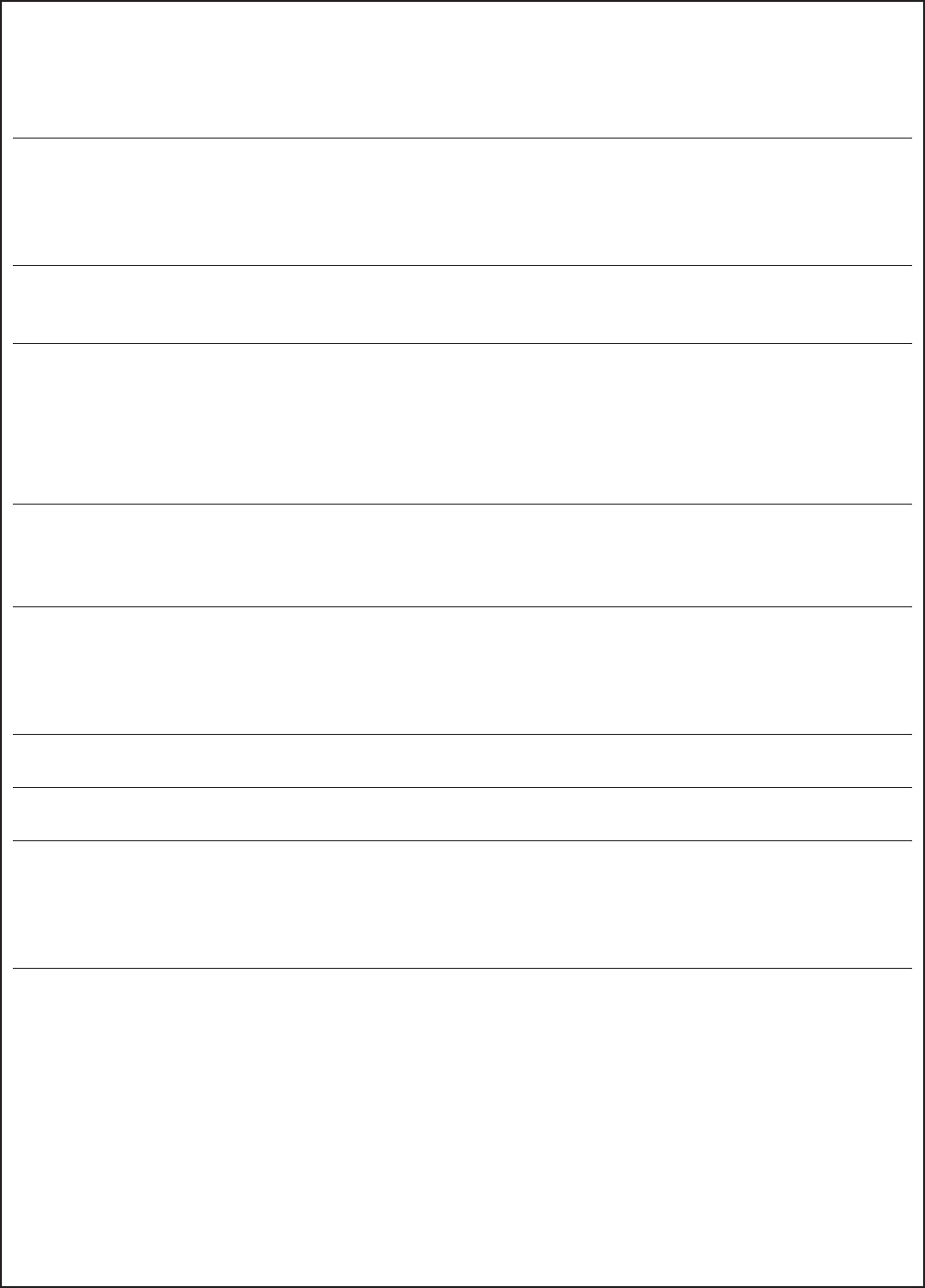
Owner's Manual for Thern 477 Series Power Winches page 19
A5445J-0917
Table 2 – Troubleshooting Chart
Contact the factory for detailed instructions on re-sealing the gearbox if you are required to disassemble the
gearbox for any reason. Disassembly of the gearbox before contacting Thern, Inc. voids all warranties.
problem cause correction
motor won't run ....................
................................................
..................
.............................................
.................................
motor runs, drum doesn't turn ......................
................................................
............................
motor tries to turn but can't .....................................................
......................................................
................................................
..............................................
.........................................
......................
brake does not operate properly
.......................................
...........
lubricant leakage .......................................................
................................
................................
...............................
.............
excessive end play on drive shaft .....................
........................................
excessive worn gears or bearings ......................................................
....................
overheating ..............................
......................................................
.....................................................
......................
.................................................
unusual noises
.....................................................
...................................................
.....................................
......................................................
.................................................
......................................
...........................
................................
......................................
...........
................................................

Owner's Manual for Thern 477 Series Power Winchespage 20
A5445J-0917
3.5 Repairing the Winch
3.5.1 GET FACTORY AUTHORIZATION for all repairs. Unauthorized repairs
will void the warranty, and may lead to damage or failure of the winch.
3.5.2 REPLACE DAMAGED OR POORLY OPERATING PARTS with Thern
repair parts.
3.5.3 REFINISH AREAS where the paint is worn or aking. A good nish helps
to protect against corrosion and weather damage.
a REMOVE THE FINISH from damaged areas, down to the bare metal.
b CLEAN THE AREA thoroughly.
c REPAINT with a high quality primer and nishing coat.
3.5.4 TO ORDER REPAIR PARTS, contact your local dealer. Include the
following information when ordering:
• model number
• serial number (or code number)
• part number
• date purchased, and from whom
• description of what happened, or what is wrong
• your name and return address
477 Series – Congurations and Performance Characteristics
7
1
4771
2
4
5
4777
2
6
1
2
4
5
6
7
Important!
• It is your responsibility to
determine when to replace parts.
When considering whether to
continue using a part or to replace
it, remember that replacing it
is the best way to avoid further
equipment damage.
• Replace spring pins, retaining
rings, and oil seals whenever
the winch is disassembled for
inspection or repair.
• During reassembly, use Loctite
598 Ultra Black to create a
seal between the two halves
of the gearbox. Contact the
factory for detailed instructions.
Disassembly of the gearbox
before contacting Thern, Inc
voids all warranties.
• Appoint a qualied person to be
responsible for all repairs to the
equipment.
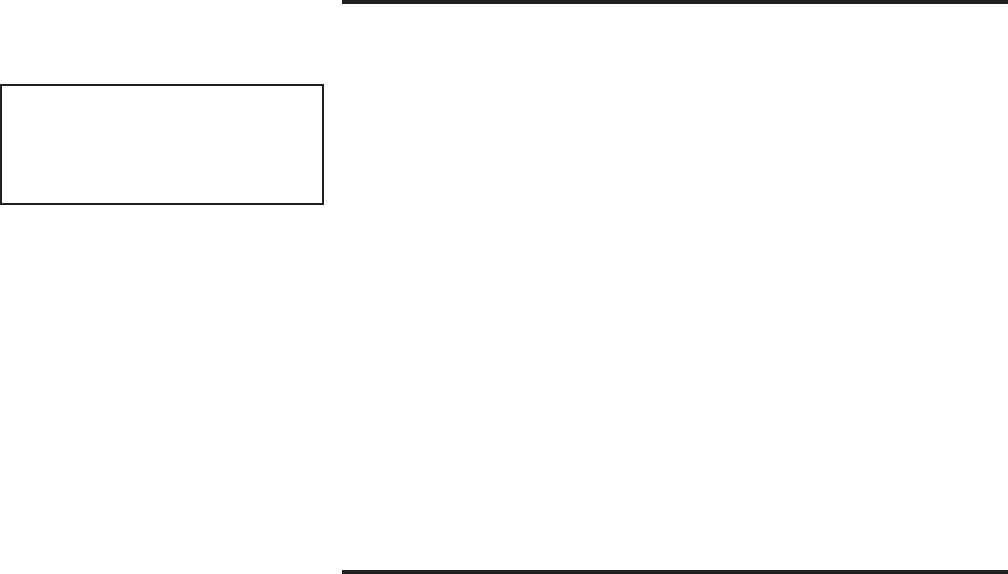
Owner's Manual for Thern 477 Series Power Winches page 21
A5445J-0917
Important!
• Keep a record of what you ship,
and when you send it.
4.1 Transporting the Winch
4.1.1 REMOVE THE BREATHER PLUG and install a sealed oil plug to prevent
the loss of lubrication during shipment.
4.1.2 PACK THE WINCH in an upright position for transport, using the original
packaging materials, if possible.
a FASTEN THE WINCH to a wooden base using lag bolts, to keep it from
moving during transport.
b SEAL THE WINCH in plastic with a desiccant to help protect it from rust,
corrosion, and other damage.
c CONSTRUCT WOODEN SIDES and top to enclose the winch in a solid
protective crate.
d PACK LOOSE PARTS in small boxes or ship separately.
4.1.3 INSPECT THE WINCH according to the Instructions for Periodic Inspection
before installing it in a new location.
4.2 Storing the Winch
4.2.1 LUBRICATE THE WINCH as necessary, and make sure the breather plug is
clean and properly installed. Add a rust preventative for long term storage.
4.2.2 SEAL THE WINCH in plastic with a desiccant to help protect it from rust,
corrosion, and other damage.
4.2.3 STORE THE WINCH upright, in a cool clean place away from corrosive
chemicals and moisture.
4.2.4 ROTATE THE DRUM periodically to keep bearing and gears surfaces from
becoming lacquered.
4.2.5 INSPECT THE WINCH according to the Instructions for Periodic Inspection
before installing it for operation.
4.2.6 TEST INSULATION RESISTANCE in the motor to detect moisture
damage. Refer to the motor manufacturer’s instructions.
4.2.7 LUBRICATE THE WINCH PROPERLY prior to operation. See section 3.3 -
Lubricating the Winch.
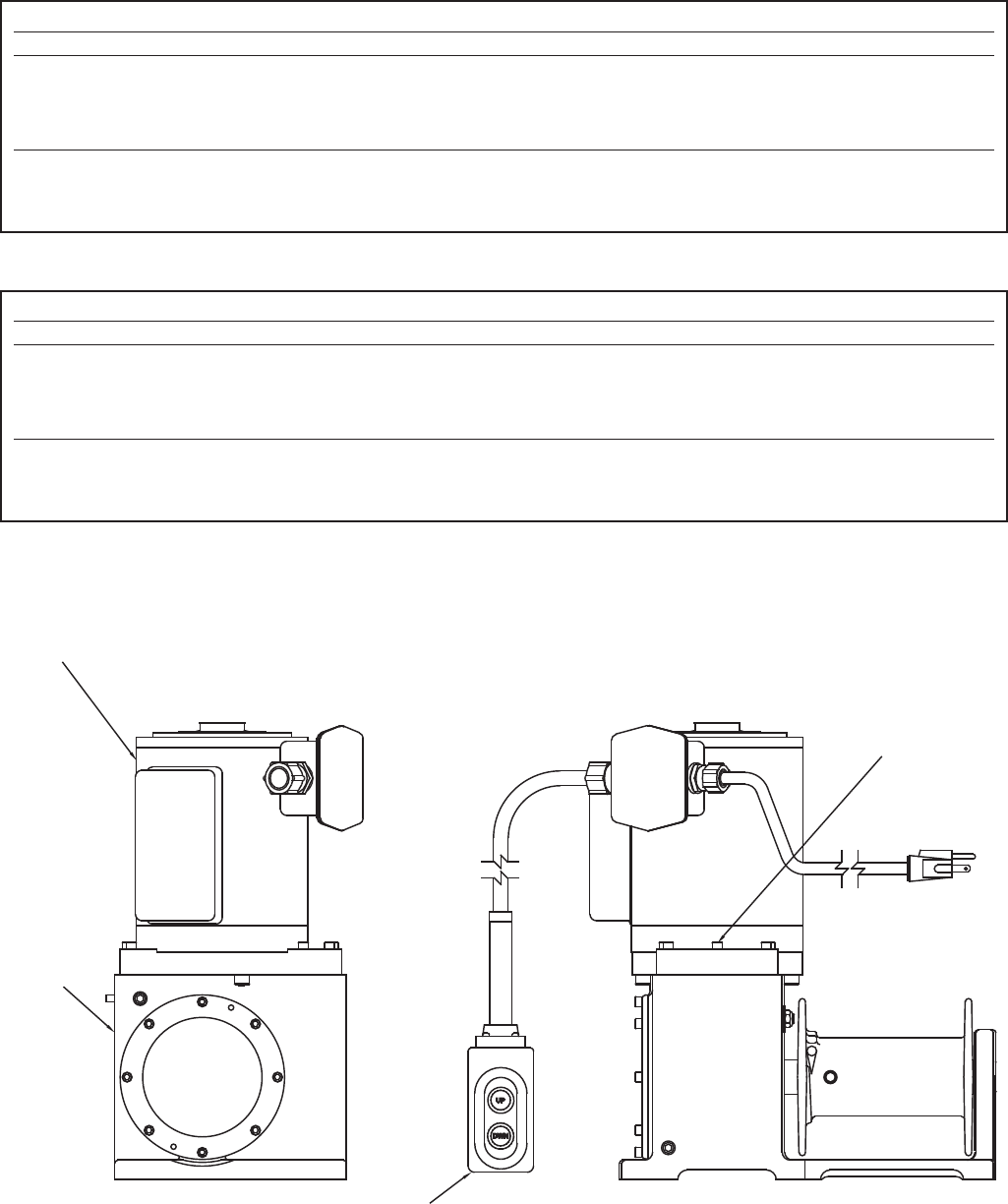
Owner's Manual for Thern 477 Series Power Winchespage 22
A5445J-0917
3
2
1
4
4771 Series 4771 4771AC 4771DC 4771HY 4771PN
item description part no. part no. part no. part no. part no. qty.
1
2 D1631 D1631 D1631 D1719 D1631 1
3
4
5
1
6
1
7
1
1
4777 Series 4777 4777AC 4777DC 4777HY 4777PN
item description part no. part no. part no. part no. part no. qty.
1
2
3
4
5
1
6
1
7
1
1
4771 Power Winch
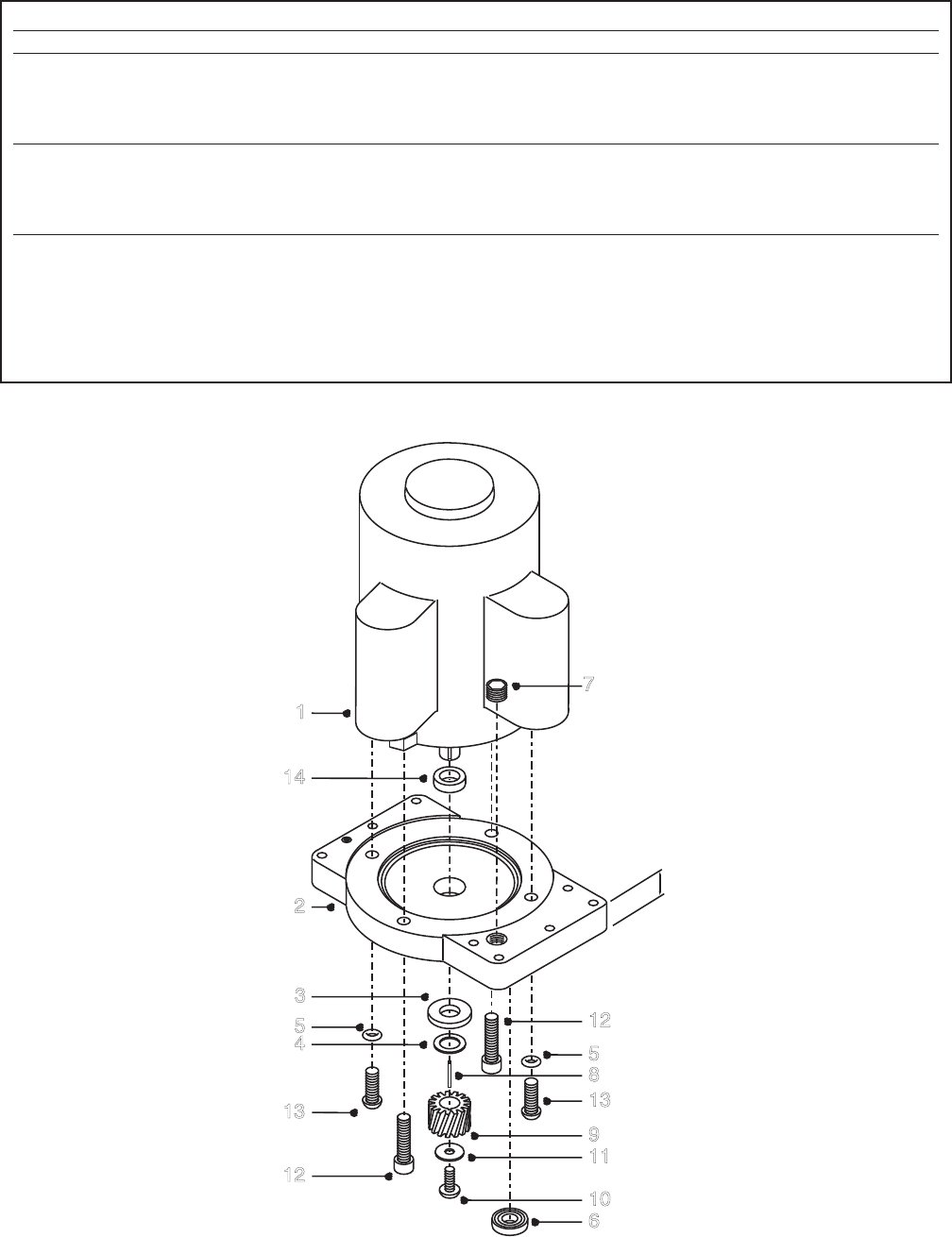
Owner's Manual for Thern 477 Series Power Winches page 23
A5445J-0917
477 Series Motor Adapter Assembly
1
C2906 C3115 C2949
item description part number qty part number qty part number qty
1
2
2
D1169 1 D1169 1 D1169 1
3
4
5
6
7
9
11
12
13
14
1
2
1
14
2
3
5
4
13
12
8
9
11
10
6
13
5
12
7
C2906 Motor Adapter Assembly
2
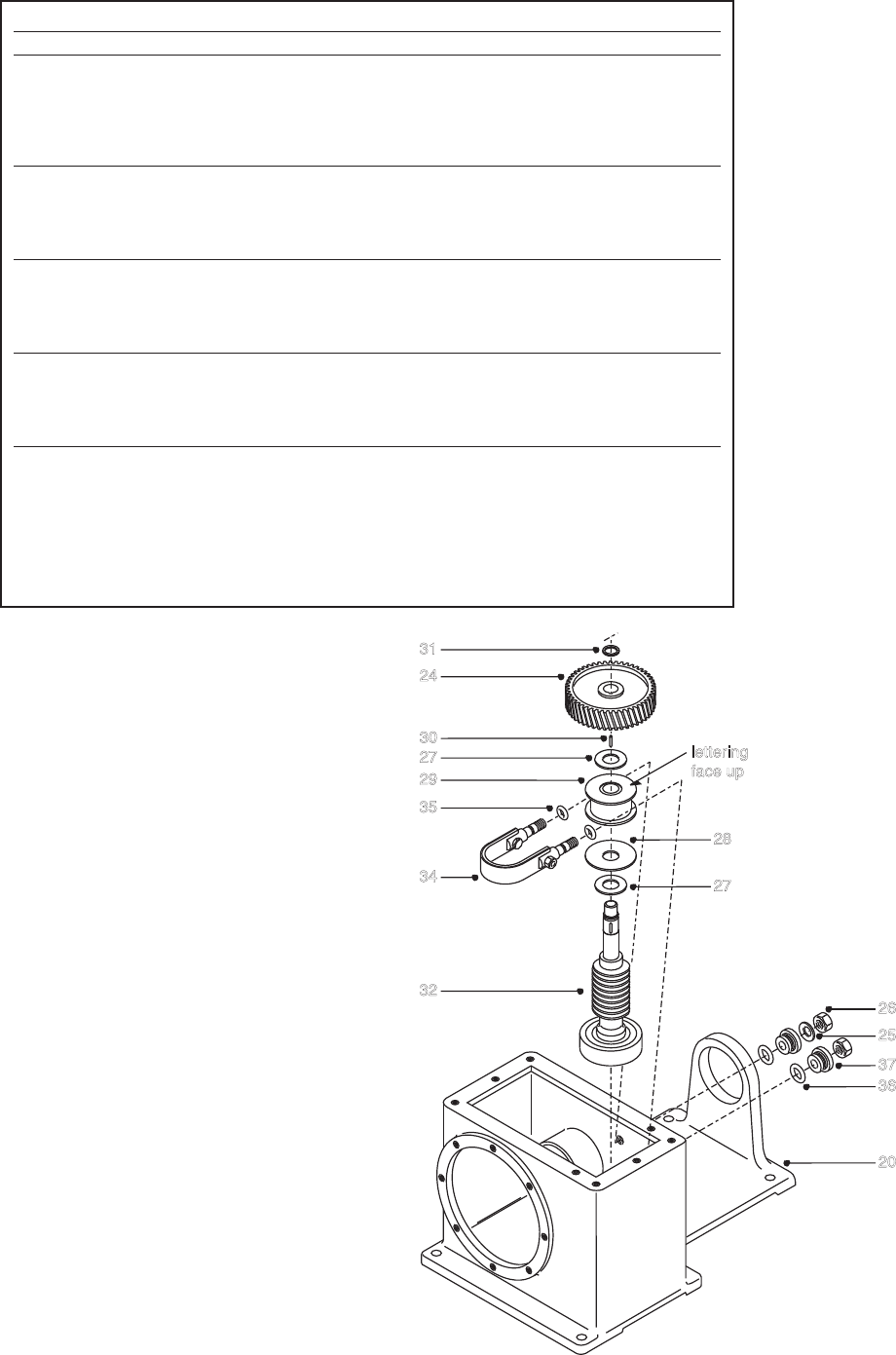
Owner's Manual for Thern 477 Series Power Winchespage 24
A5445J-0917
27
30
31
24
29
35
34
32
27
28
lettering
face up
26
25
37
36
20
T
H
I
S
S
I
D
E
U
P
477 Series Reducer Assembly
3
D1631 D1706
item description part number part number qty.
15
1
16
17
19
2
D1257 D1257 1
21
22
23
24
25
26
27
29
31
32
2
33
34
2
35
36
37
39
2
1
2
3
D1631 Reducer Assembly
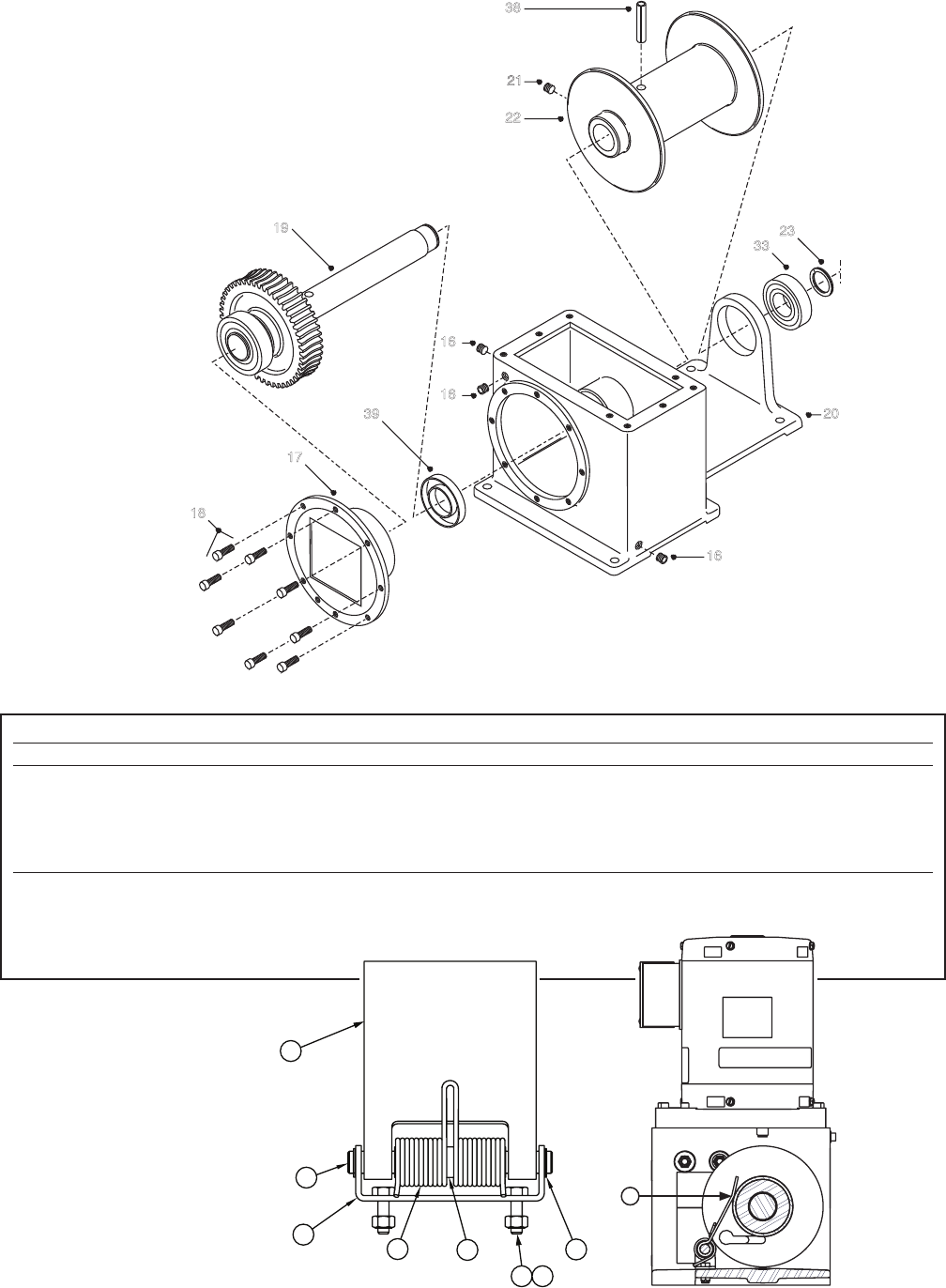
Owner's Manual for Thern 477 Series Power Winches page 25
A5445J-0917
39
33
23
19
17
18
16
16
16
20
21
22
38
D1631 Reducer Assembly
Pressure Plate Assembly B2085
1
B2083
2
item description part number qty. part number qty.
1
2
1
1
2
3
4
5
6
8
7
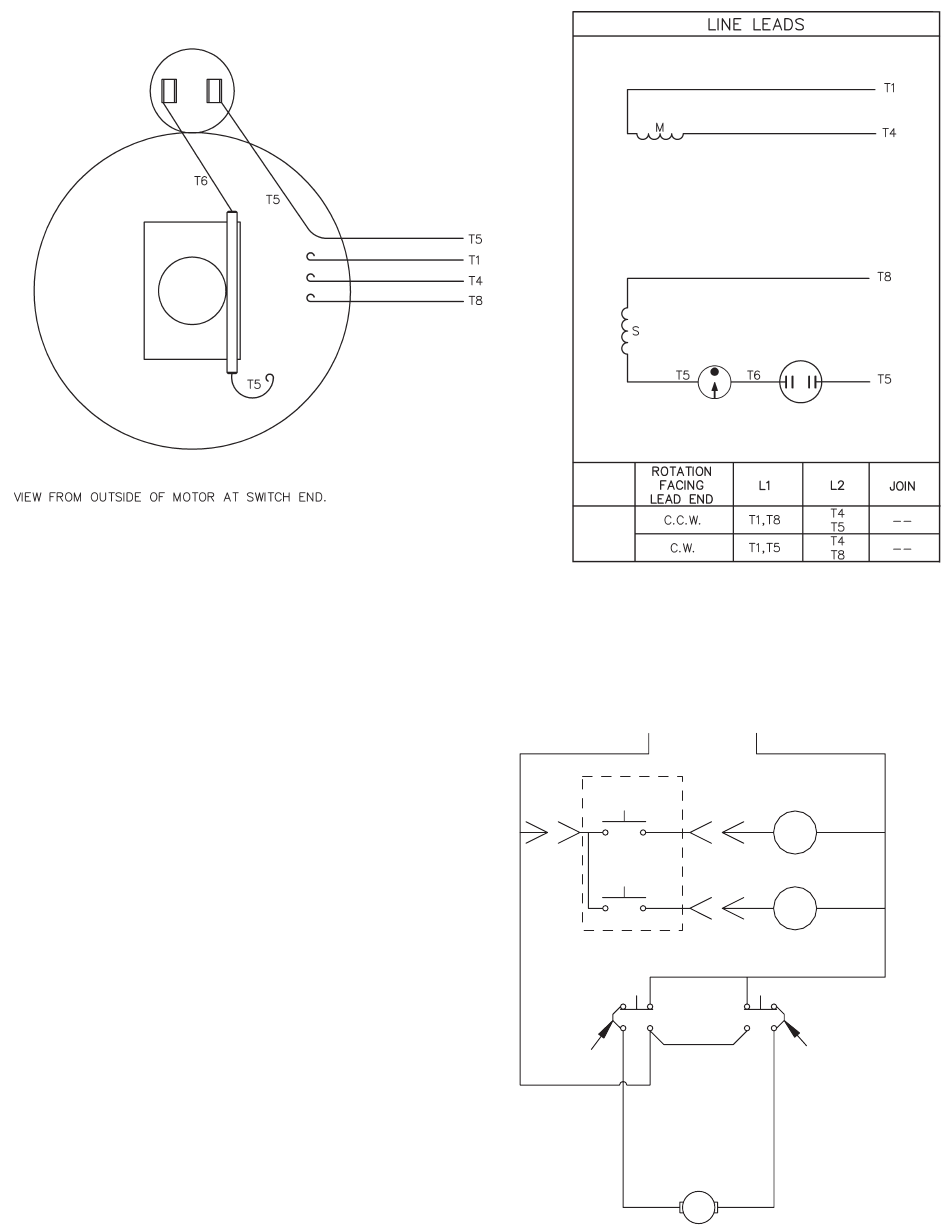
Owner's Manual for Thern 477 Series Power Winchespage 26
A5445J-0917
12/24 VOLT DC REVERSING
12/24 VOLT DC SUPPLY
+
-
UP PB
DWN PB
SV1
SV2
SV1
SV2
12/24 VOLT DC MOTOR
JMPR1
JMPR2
JMPR3
Models ending in -DC are
equipped with DC Motors
Electric DC Schematic
for 12/24 volt DC Controls
1
477 Series
Electric AC Schematic for B5495 Motor
1
1
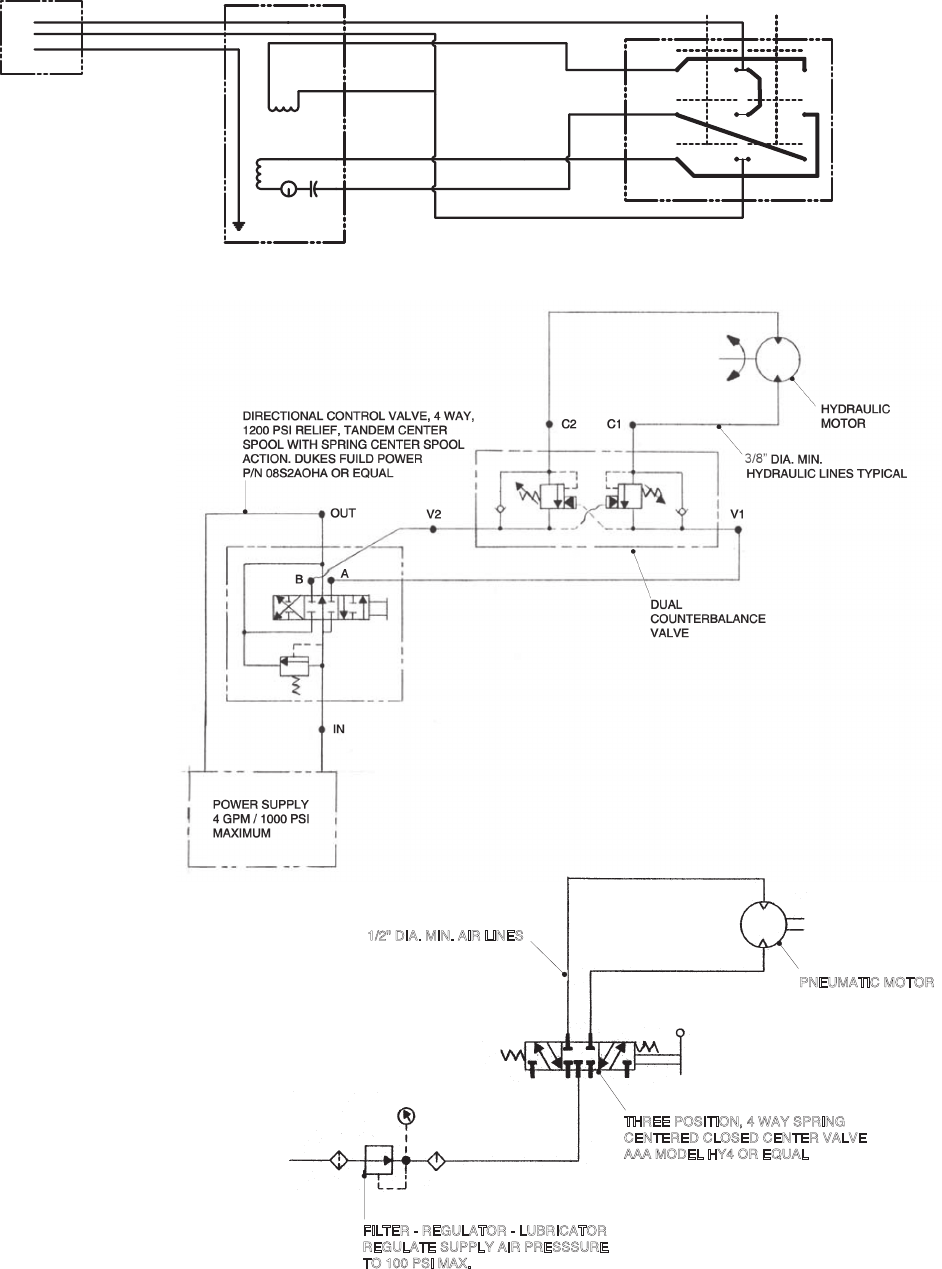
Owner's Manual for Thern 477 Series Power Winches page 27
A5445J-0917
477 Series
Electric AC Schematic for C3048 Control Assembly
1
RED
T8
T5
POWER
CORD
CONDUIT BOX
MOTOR
GREEN
WHITE
BLACK
GREEN
W/BLK
T4
T1
BLACK
9
7
8
6
3
12
4
5
WHITE
BLACK
GREEN W/BLK
RED
ORANGE
WHITE
ORANGE
UP/FWD
DWN/REV
SINGLE PHASE, TYPE L
115 VOLT, REVERSIBLE
4 LEAD TO 1 1/2 HP
Models ending in -PN are
equipped with Air Motors
Pneumatic Schematic
for B1738 Motor
1
Models ending in -HY are
equipped with Hydraulic Motors
Hydraulic Schematic
for A5060 Motor
1
1/2" DIA. MIN. AIR LINES
FILTER - REGULATOR - LUBRICATOR
REGULATE SUPPLY AIR PRESSSURE
TO 100 PSI MAX.
THREE POSITION, 4 WAY SPRING
CENTERED CLOSED CENTER VALVE
AAA MODEL HY4 OR EQUAL
PNEUMATIC MOTOR
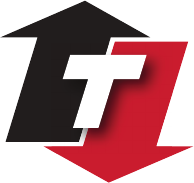
Thern, Incorporated
Thern Europe
Thern
Winches & Cranes
